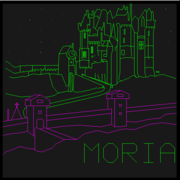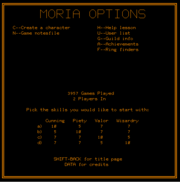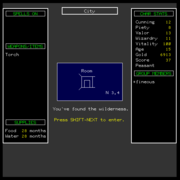.gif)
Moria (PLATO)
Encyclopedia

Dungeon crawl
A dungeon crawl is a type of scenario in fantasy role-playing games in which heroes navigate a labyrinthine environment, battling various monsters, and looting any treasure they may find...
style computer role-playing game first developed for the PLATO system around 1975, with copyright dates listed as 1978 and 1984. It was a pioneering game, allowing parties of up to ten players to travel as a group and message each other, dynamically generating dungeons (instead of pre-computing them), and featuring a wireframe
Wireframe
Wireframe or wire frame may refer to:* Wire-frame model, visual presentation of a three dimensional or physical object used in 3D computer graphics* Website wireframe, a basic visual guide used in web design...
first-person perspective display. One of its authors, Kevet Duncombe, claims not to have read the works of J. R. R. Tolkien
J. R. R. Tolkien
John Ronald Reuel Tolkien, CBE was an English writer, poet, philologist, and university professor, best known as the author of the classic high fantasy works The Hobbit, The Lord of the Rings, and The Silmarillion.Tolkien was Rawlinson and Bosworth Professor of Anglo-Saxon at Pembroke College,...
or heard of Dungeons & Dragons
Dungeons & Dragons
Dungeons & Dragons is a fantasy role-playing game originally designed by Gary Gygax and Dave Arneson, and first published in 1974 by Tactical Studies Rules, Inc. . The game has been published by Wizards of the Coast since 1997...
at the time development started, but he was aware of the PLATO game, dnd
Dnd (computer game)
dnd is a computer role-playing game. The name dnd is derived from the abbreviation "DND" from the original role-playing game Dungeons & Dragons, which was first released in 1975....
.
Characters

In Moria, character generation is automatic. A player chooses from among four possible skill combinations, each totaling to the same amount. The game does not enforce a rigid notion of character class; characters may use any weapon or spell as their individual skill levels permit.
A character's Vitality level combines the concepts of character level, hit points, and endurance. A character's vitality level determines chances of success or cost of actions such as fighting or fleeing a monster and spell-casting. Performing actions, sustaining damage, or depleting food and water supplies consumes Vitality. Each turn a character rests while stocked with food and water restores Vitality. Should Vitality drop to zero, the character dies.
Score points are given for defeating monsters.
Equipment
Characters carry and use several types of weapons and armor. In Moria, all are called weapons, each with an offensive and a defensive rating. Thus, a battle axeBattle axe
A battle axe is an axe specifically designed for combat. Battle axes were specialized versions of utility axes...
may have a defensive value of 3 and an offensive value of 8, while light armor has a defensive value of 10, but an offensive value of 0. Characters have a one slot for each type, except for "fighting" weapons, as players with high Valor skill may use two one-handed weapons simultaneously.
Gold is an important measure of success in the game. The gold piece is the basic monetary unit, with 200,000 pieces of gold measured as one bag of gold.
The dungeons contain certain magic objects. The most notable is the "Ring of the Reaper" which extends character lifespan. Characters who find this ring and defeat its guardian are listed on a hall of fame page.
Terrain and survival

The town is adjacent to the wilderness area, which contains a few less challenging monsters and not much treasure. The wilderness in turn contains stairs to the four main dungeon areas: cave, mountain, forest, and desert. Despite the naming of these areas, on-screen presentation is identical. Each is sixty levels deep, with staircases leading from one to the next.
Dungeon areas are composed of six by six "blocks", and thus contain 36 spaces potentially occupied by characters or monsters. Blocks contain walls and doors that partition them into corridors and rooms; most blocks will also contain inaccessible spaces. Doors lead both within and between blocks. The coordinate position of a player within the current block is displayed on-screen, along with which of the four cardinal directions the character faces.
Characters require food and water to survive, automatically consuming both with the passage of game time. Once these resources are depleted, the character's Vitality decrements until the player secures new supplies. A player has a limited capacity to carry food and water, which may be purchased in town. Some monsters may be converted to food when killed, and water holes may be found in the dungeons.
Combat and other actions
The game primarily uses single-letter, case-sensitive commands, some of which are mnemonicMnemonic
A mnemonic , or mnemonic device, is any learning technique that aids memory. To improve long term memory, mnemonic systems are used to make memorization easier. Commonly encountered mnemonics are often verbal, such as a very short poem or a special word used to help a person remember something,...
. The character motion keys are graphically oriented on a QWERTY
QWERTY
QWERTY is the most common modern-day keyboard layout. The name comes from the first six letters appearing in the topleft letter row of the keyboard, read left to right: Q-W-E-R-T-Y. The QWERTY design is based on a layout created for the Sholes and Glidden typewriter and sold to Remington in the...
keyboard; 'a' turns left, 'd' turns right, 'x' turns around, 'w' moves forward, and 'W' moves forward through a door, or until an object is encountered. Many actions, such as object use, will present lists of choices. Some actions make use of special keys found on PLATO terminals.
In combat with monsters, a player has several options:
- attack the monster
- trick the monster, which instantly kills it if successful
- bribe the monster with gold or an item in exchange for the monster leaving (if of sufficient value)
- run away, dependent on the Cunning skill
- evade the monster's attacks
- cast an offensive spell
- pray, the chances of success decreasing if the player prays for help too often
Additional actions include:
- casting non-combat spells
- using or discarding items
- make a camp, or access an existing camp if the character is in the same room
- yell for help or yell to any one player anywhere in the game
- join and leave a party from within the same room as the party
- kick someone out of a party (only available to party guides)
- run to another party member
- give food, water, or a magic item to another player
Parties
When players form a party, one acts as "Guide" who has sole control over party movement between areas of the terrain ("blocks"). Several rooms comprise each block, in which players can independently move, loot, combat monsters, and so on. The party cannot leave a block if anyone in the party is fighting. Players in a party may message all players, or one other player privately, in the current room.Magic strings
Moria features the rather unusual gameplay mechanic of "the magic string", similar in concept to a GPSGlobal Positioning System
The Global Positioning System is a space-based global navigation satellite system that provides location and time information in all weather, anywhere on or near the Earth, where there is an unobstructed line of sight to four or more GPS satellites...
waypoint
Waypoint
A waypoint is a reference point in physical space used for purposes of navigation.-Concept:Waypoints are sets of coordinates that identify a point in physical space. Coordinates used can vary depending on the application. For terrestrial navigation these coordinates can include longitude and...
. Each player possesses a single string that is tied to a specific dungeon location, to which the player can retrace subsequent steps. Strings cannot cross dungeon levels, and on more advanced levels, monsters will occasionally chew through them, preventing return. While party members may tie individual strings, only the party guide's can be traversed, though other players can follow their individual strings by leaving the party.
Camps
A player may establish a camp in the dungeon, which is basically a supply depot where they can store up to sixty bags of gold and sixty months worth of food. The camp can also serve as a teleport point.Guilds
The game features four guilds which players can join, each oriented toward a character class: the Thieves Guild, the Brotherhood for clerics, the Union of Knights, and the Circle of Wizards. Once characters possess a level of 20 in the appropriate skill (Cunning, Piety, Valor, and Wizardry respectively), they may pay to join a guild. Guilds offer four levels of membership — apprentice, journeyman, counselor, and master — and moving from one to the next requires greater skill as well as payment in gold. The master of the guild is the guild's active character of the highest skill level.Joining a guild provides access to a guild locker, which can be used to store items and from which a new character can inherit the items of an old character who has died. Joining also grants characters a special ability. Members of the Brotherhood can heal their party's vitality, knights can behead opponents (a critical hit
Critical hit
In many role-playing games and video games, a critical hit is a successful attack that deals more damage than a normal blow.-Origin:The 1975 role-playing game Empire of the Petal Throne introduced the concept of critical hits...
in gaming parlance) and take less damage, thieves' chances of finding magic objects improves, and wizards can teleport their party to their camp or to the location of another player in the dungeons.
Sources
- Moria at cyber1.org, where one may play the game
- Fun with PLATO at Armchair Arcade

